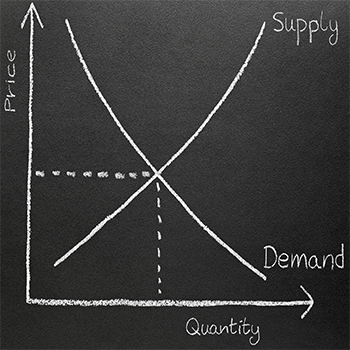Demand-Shaping With Supply in Mind

Supply chain managers must advocate for “demand-shaping with supply in mind,” meaning that demand-shaping decisions aren’t made in isolation of supply issues.
At many of the supply chain events I attend, a slew of speakers advocate demand-sensing and shaping - as do I. Usually, we are referring to these activities in the context of leveraging various downstream demand signals and their associated plans, such as historical point-of-sale (POS), warehouse withdrawal, and distributor/retailer inventory data.
Supply chain managers in the audiences must scratch their heads and wonder why we are discussing demand-shaping with them.
After all, demand-shaping isn’t their problem; nor are they directly affected should revenue goals not be met. That is the responsibility of managers in the marketing and sales departments. They are held accountable by the executive team for achieving revenue goals.
Their performance reviews, pay raises, promotions, and job security are predicated upon meeting, and sometimes exceeding, revenue goals. That said, while supply-side managers don’t make any final decisions regarding demand-shaping activities, they have important support roles to play. The most important is ensuring that supply is available when customer demand materializes.
To that end, supply chain managers should be advocates for “demand-shaping with supply in mind.” That is, they need to ensure that demand-shaping decisions aren’t made in isolation of supply issues. Generally this involves identifying supply issues, such as an inventory or parts shortage or surplus, and then creating sales programs aimed at ameliorating the issue.
Doing a better job of aligning demand with supply eliminates waste, improves service, and leads to improved profitability - in contrast to only enhancing revenue which demand-side managers are largely concerned with. During S&OP meetings, supply-side managers should make sure to vet all sales and marketing plans in terms of whether or not they align with potential available supply and with profitability goals.
Supporting Competitive Demand-Shaping
As anyone who has taken a basic marketing course will remember, marketing and sales activities fall under four categories.
They are termed the 4Ps of the marketing mix: 1) Price, 2) Promotion, 3) Product, and 4) Place.
Most supply chain managers have no influence in the decisions made by marketing and sales managers. Yet the ramifications make their jobs harder and often result in increased demand volatility and uncertainty. For example, at most consumer packaged goods (CPG) companies, these types of “self-inflicted” demand variations (due to product promotions) are a company’s dominant source of demand variation.
This complicates the job of supply chain managers who favor constancy in demand so they can buy lots of materials and components to take advantage of volume discounts, make long production runs (i.e., make the same product over and over again), and fill up warehouses and load trucks with the same types of goods. Nevertheless, supply chain managers need to support 4P competitive activities. This can happen in multiple ways.
The first P of Marketing (Price) involves establishing and changing product prices. These activities cause significant demand variation and uncertainty depending upon the price elasticity of products and competitive reactions. Establishing the price for a new product is very risky and leads to significant uncertainty in demand. Revising the price of a mature product is less risky, but still causes significant demand variation. Supply chain managers can support pricing decisions and demand variations and uncertainties in several ways.
For example, they can carry material and component buffer stocks, reserve excess manufacturing capacity, and maintain safety stocks of finished goods.
THE DEMAND SENSING REVOLUTION
Creating a Superior Short-Term Demand Signal

Companies are struggling with demand variability and how to meet consumer demand with the right supply at the right location at the right time. A new technique called Demand Sensing, by generating highly accurate short-term demand signals, can enable companies to meet consumer demand while driving the lowest cost possible across their distribution, manufacturing, and procurement activities. Could Demand Sensing help your company?
In this webinar, experts from the world of CPG and enterprise software, Mark Sims and Mark Zelenak, will share how One Network has worked with one of the world’s largest consumer goods companies to implement a demand sensing solution that is being used to increase on-shelf availability at the world’s largest retailer. Drawing lessons from this actual case study, the following questions will be answered:
- What is demand sensing and how does it reduce demand variability?
- Why is a shared collaborative framework for both retailers and suppliers important?
- How are challenges like product turnover, seasonal patterns, promotions, and thousands of inventory locations best managed?
Attendees at this session will learn how actual companies are:
- Capturing true consumer demand under constrained supply conditions
- Maximizing their revenue and trading partner revenue while minimizing inventory
- Gaining insight with smart analytics that give visibility into lost sales, retailer orders, and forecast accuracy
We hope you can join us!
PS: If you can’t make the live date, you can still register today and attend anytime after the broadcast - we’ll send you a reminder when the Webinar is available On-Demand.
The second P of Marketing (Promotion) involves activities aimed at promoting and selling products to potential customers. As with pricing activities, these cause significant demand variations and uncertainties. Prior to a promotional campaign the primary role of supply chain managers is to fill downstream supply chains with product to cover the often substantial uplift in expected demand.
The third P of marketing (Product) involves establishing and changing the portfolio of products sold, including the introduction of new and reformulated products and the phasing out of old obsolete products. New product launches especially have significant demand uncertainty. Yet it is important to ensure that product is available to satisfy first-time buyers. Supply chain managers need to execute launches by initially filling downstream supply chains with sufficient inventories, as well as helping to ensure new products are positioned at the points of sale. As a product launch progresses, supply needs to be replenished all along the downstream supply chains, as well as at the points of sale.
The fourth P of marketing (Place) involves establishing the distribution and sales channels through which products are made available for sale. Similar to new product launches, opening a new channel involves very significant demand variation and uncertainty. It involves establishing the ways products will flow and be inventoried throughout a new channel, as well as initially stuffing and replenishing it with inventory. For example, establishing an online Internet sales channel often involves deploying new order fulfillment and supply strategies, such as piece picking, packing, and shipping in customer-facing warehouses.
Advocating “Demand-Shaping With Supply in Mind”
The best example I know of a supply chain group that successfully implemented “demand-shaping with supply in mind” is Dell, during its heyday. We researched its practices during the first phase of the MIT Supply Chain 2020 Project that involved research into excellence. Every day a team of Dell managers met to discuss whether or not to revise the merchandizing of products sold online via the website.
The team assessed the “consigned” inventories of components at supplier warehouses. If they uncovered components that had excessive inventories, the team would alter the daily list of specially promoted items to include computer configurations that included these components. In contrast, if they uncovered components that had inventory shortages, the team would “de-promote” them. This meant taking them off the daily list of specially promoted items, raising their prices, and increasing their delivery lead times. Essentially the Dell team was running a quasi-S&OP process daily.
Remember what we stated at the outset: As a rule, “demand shaping with supply in mind” involves identifying supply issues and creating sales programs aimed at ameliorating them; thereby achieving a better alignment of supply with selling activities and enhanced profitability. If there is an excess of materials and components, underutilized plants, or a surplus of finished goods inventories, supply chain managers ought to work with sales and marketing managers to develop programs aimed at correcting these excess supply situations that might result in significant inventory obsolescence and write-offs.
On the other hand if there are shortages of any type of supply, then marketing and sales should be convinced into changing demand plans to not aggressively sell products impacted by the shortages. If demand winds up exceeding supply for these products, supply chain managers will have to execute emergency procedures to meet the excess demand; and this will lead to increased costs and reduced profits. These include procedures such as paying higher (e.g., “spot market”) prices for procured materials and components, expediting procurement orders, adding emergency/overtime shifts at production plants, and expediting customer shipments.
Supply chain managers must recognize that they have a role in shaping demand. In addition to their primary role of ensuring that sufficient supply is in place to meet demand generated by marketing and sales activities, they need to ensure that demand is most profitably aligned with potentially available supply. This means that demand-shaping should be done “with supply in mind,” and not done independent of supply considerations.
Joint decision-making with demand-side managers should be incorporated within integrated supply-demand planning processes, such as in the S&OP process. Doing so will shift sales and marketing goals from just maximizing revenue towards maximizing profits as well - and that is a good thing.
Related: A Practitioner’s Guide to Demand Planning

Article Topics
SAS News & Resources
C.H. Robinson and SAS introduce new dynamic business planning-based partnership New Perspectives on the Value of Demand Sensing Unlocking the Promise of Demand Sensing and Shaping Through Big Data Analytics Demand-Shaping With Supply in MindLatest in Supply Chain
Microsoft Unveils New AI Innovations For Warehouses Let’s Spend Five Minutes Talking About ... Malaysia Baltimore Bridge Collapse: Impact on Freight Navigating TIm Cook Says Apple Plans to Increase Investments in Vietnam Amazon Logistics’ Growth Shakes Up Shipping Industry in 2023 Spotlight Startup: Cart.com is Reimagining Logistics Walmart and Swisslog Expand Partnership with New Texas Facility More Supply Chain














